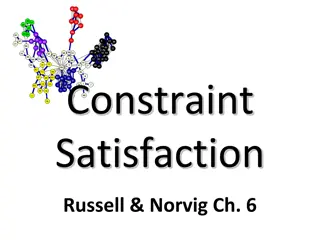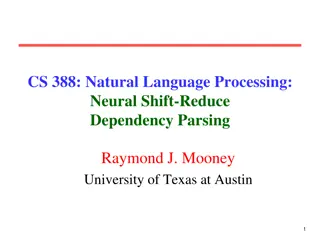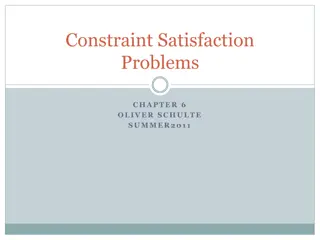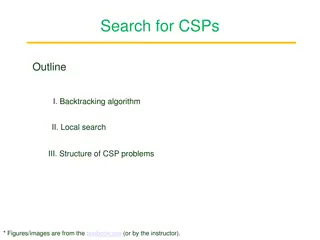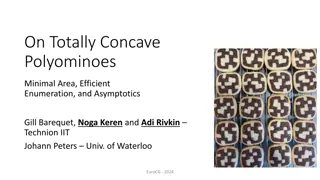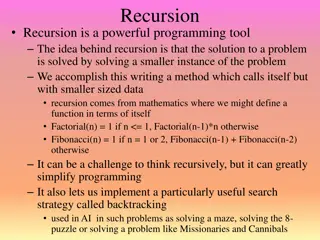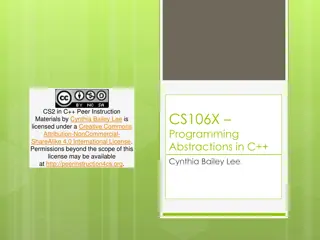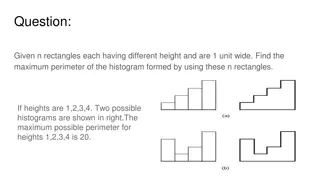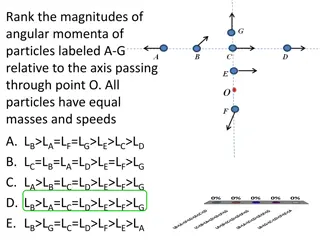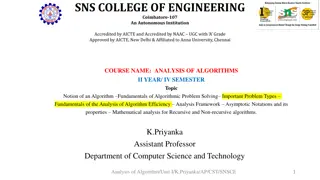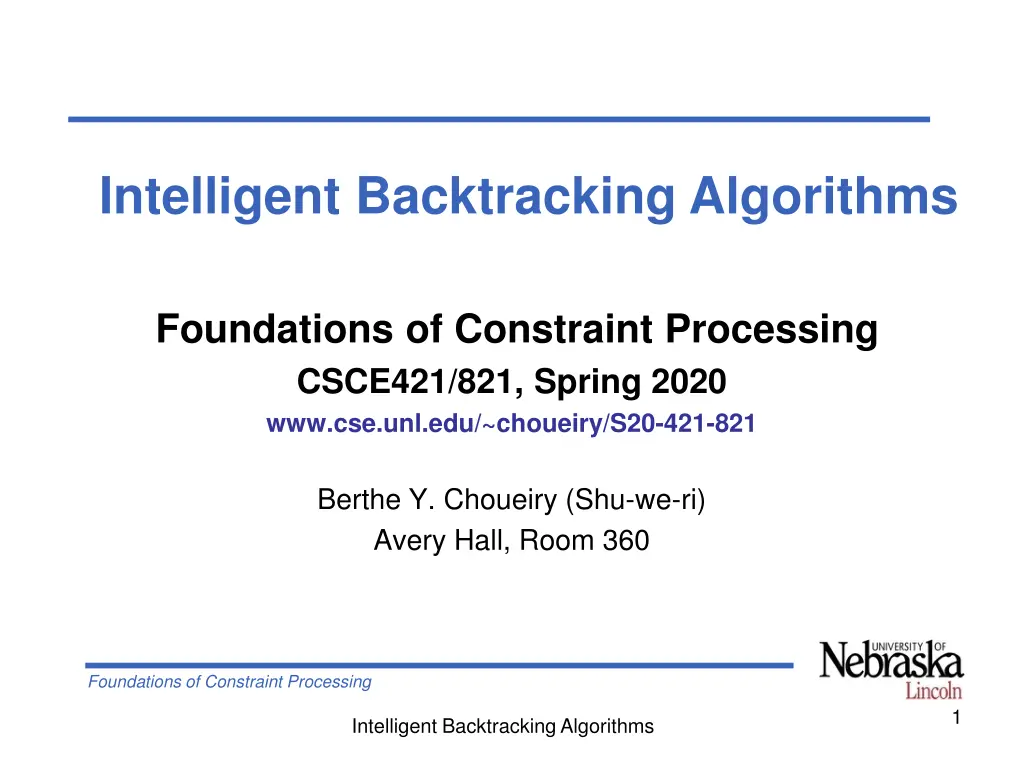
Intelligent Backtracking Algorithms - Foundations of Constraint Processing
Explore the foundations and principles of intelligent backtracking algorithms in constraint processing. Topics include hybrid algorithms, variable ordering, search tree traversal, back-checking, and consistency checking methods for efficient problem-solving. Recommended readings and terminology reviews included.
Download Presentation

Please find below an Image/Link to download the presentation.
The content on the website is provided AS IS for your information and personal use only. It may not be sold, licensed, or shared on other websites without obtaining consent from the author. If you encounter any issues during the download, it is possible that the publisher has removed the file from their server.
You are allowed to download the files provided on this website for personal or commercial use, subject to the condition that they are used lawfully. All files are the property of their respective owners.
The content on the website is provided AS IS for your information and personal use only. It may not be sold, licensed, or shared on other websites without obtaining consent from the author.
E N D
Presentation Transcript
Intelligent Backtracking Algorithms Foundations of Constraint Processing CSCE421/821, Spring 2020 www.cse.unl.edu/~choueiry/S20-421-821 Berthe Y. Choueiry (Shu-we-ri) Avery Hall, Room 360 Foundations of Constraint Processing 1 Intelligent Backtracking Algorithms
Reading Required reading Hybrid Algorithms for the Constraint Satisfaction Problem [Prosser, CI 93] Recommended reading Chapters 5 and 6 of Dechter s textbook Tsang, Chapter 5 Foundations of Constraint Processing 2 Intelligent Backtracking Algorithms
Outline Review of terminology of search Hybrid backtracking algorithms Foundations of Constraint Processing 3 Intelligent Backtracking Algorithms
Backtrack search (BT) Variable/value ordering S Variable instantiation (Current) path Current variable Var 1 v2 v1 Past variables Future variables Shallow/deep levels /nodes Search space / search tree Back-checking Backtracking Foundations of Constraint Processing 4 Intelligent Backtracking Algorithms
Outline Review of terminology of search Hybrid backtracking algorithms Vanilla: BT Improving back steps: {BJ, CBJ} Improving forward step: {BM, FC} Foundations of Constraint Processing 5 Intelligent Backtracking Algorithms
Two main mechanisms in BT 1. Backtracking: To recover from dead-ends To go back 2. Consistency checking: To expand consistent paths To move forward Foundations of Constraint Processing 6 Intelligent Backtracking Algorithms
Backtracking To recover from dead-ends 1. Chronological (BT) 2. Intelligent Backjumping (BJ) Conflict directed backjumping (CBJ) With learning algorithms (Dechter Chapt 6.4) Etc. Foundations of Constraint Processing 7 Intelligent Backtracking Algorithms
Consistency checking To expand consistent paths 1. Back-checking: against past variables Backmarking (BM) 2. Look-ahead: against future variables Forward checking (FC) (partial look-ahead) Directional Arc-Consistency (DAC) (partial look-ahead) Maintaining Arc-Consistency (MAC) (full look-ahead) Foundations of Constraint Processing 8 Intelligent Backtracking Algorithms
Hybrid algorithms Backtracking + checking = new hybrids BT BM FC BJ BMJ FC-BJ CBJ BM-CBJ FC-CBJ Evaluation: Empirical: Prosser 93. 450 instances of Zebra Theoretical: Kondrak & Van Beek 95 Foundations of Constraint Processing 9 Intelligent Backtracking Algorithms
Notations (in Prossers paper) Variables: Vi, i in [1, n] Domain: Di= {vi1, vi2, ,viMi} Constraint between Viand Vj: Ci,j Constraint graph: G Arcs of G: Arc(G) Instantiation order (static or dynamic) Language primitives: list, push, pushnew, remove, set-difference, union, max-list Foundations of Constraint Processing 10 Intelligent Backtracking Algorithms
Main data structures v: a (1xn) array to store assignments v[i] gives the value assigned to ithvariable v[0]: pseudo variable (root of tree), backtracking to v[0] indicates insolvability domain[i]: a (1xn) array to store the original domains of variables current-domain[i]: a (1xn) array to store the current domains of variables Upon backtracking, current-domain[i] of future variables must be refreshed check(i,j): a function that checks whether the values assigned to v[i] and v[j] are consistent Foundations of Constraint Processing 11 Intelligent Backtracking Algorithms
Generic search: bcssp 1. 2. 3. 4. 5. 6. Procedure bcssp (n, status) Begin consistent true status unknown i 1 While status = unknown 7. Do Begin 8. If consistent 9. Then i label (i, consistent) 10. Else i unlabel (i, consistent) 11. If i > n 12. Then status solution 13. Else If i=0 then status impossible 14. End End Forward move: x-label Backward move: x-unlabel Input: i: current variable, consistent: Boolean Return: i: new current variable 15. Foundations of Constraint Processing 12 Intelligent Backtracking Algorithms
Chronological backtracking (BT) Uses bt-label and bt-unlabel bt-label: When v[i] is assigned a value from current-domain[i], we perform back-checking against past variables (check(i,k)) If back-checking succeeds, bt-label returns i+1 If back-checking fails, we remove the assigned value from current- domain[i], assign the next value in current-domain[i], etc. If no other value exists, consistent nil (bt-unlabel will be called) bt-unlabel Current level is set to i-1 (notation for current variable: v[h]) For all future variables j: current-domain[j] domain[j] If domain[h] is not empty, consistent true (bt-label will be called) Note: for all past variables g, current-domain[g] domain[g] Foundations of Constraint Processing 13 Intelligent Backtracking Algorithms
BT-label 1. 2. 3. 4. Function bt-label(i,consistent): INTEGER BEGIN consistent false For v[i] each element of current-domain[i] while not consistent 5. Do Begin 6. consistent true 7. For h 1 to (i-1) While consistent 8. Do consistent check(i,h) 9. If not consistent 10. Then current-domain[i] remove(v[i], current-domain[i]) 11. End If consistent then return(i+1) ELSE return(i) END Terminates: consistent=true, return i+1 consistent=false, current- domain[i]=nil, returns i 12. 13. Foundations of Constraint Processing 14 Intelligent Backtracking Algorithms
BT-unlabel 1. 2. FUNCTION bt-unlabel(i,consistent):INTEGER BEGIN 3. h i -1 4. current-domain[i] domain[i] 5. current-domain[h] remove(v[h],current-domain[h]) 6. consistent current-domain[h] nil 7. return(h) END Selects vhto backtrack to (Uninstantiates all variables between vhand vi) Uninstantiates v[h]: removes v[h] from current-domain [h]: Is called when consistent=false and current-domain[i]=nil 8. Sets consistent to true if current-domain[h] 0 Returns h Foundations of Constraint Processing 15 Intelligent Backtracking Algorithms
Example: BT (the dumbest example ever) v[0] - {1,2,3,4,5} V1 v[1] 1 v[2] {1,2,3,4,5} 1 V2 {1,2,3,4,5} V3 v[3] 1 CV3,V4={(V3=1,V4=3)} {1,2,3,4,5} etc V4 v[4] 1 2 3 4 CV2,V5={(V2=5,V5=1),(V2=5,V5=4)} V5 v[5] {1,2,3,4,5} 1 2 3 4 5 Foundations of Constraint Processing 16 Intelligent Backtracking Algorithms
Outline Review of terminology of search Hybrid backtracking algorithms Vanilla: BT Improving back steps: BJ, CBJ Improving forward step: BM, FC Foundations of Constraint Processing 17 Intelligent Backtracking Algorithms
Danger of BT: thrashing BT assumes that the instantiation of v[i] was prevented by a bad choice at (i-1). It tries to change the assignment of v[i-1] When this assumption is wrong, we suffer from thrashing (exploring barren parts of solution space) Backjumping (BT) tries to avoid that Jumps to the reason of failure Then proceeds as BT Foundations of Constraint Processing 18 Intelligent Backtracking Algorithms
Backjumping (BJ) Tries to reduce thrashing by saving some backtracking effort When v[i] is instantiated, BJ remembers v[h], the deepest node of past variables that v[i] has checked against. Uses: max-check[i], global, initialized to 0 At level i, when check(i,h) succeeds max-check[i] max(max-check[i], h) If current-domain[h] is getting empty, simple chronological backtracking is performed from h BJ jumps then steps! 1 2 3 0 1 2 3 h-2 h-1 h h-1 h 0 i 0 0 Past variable Current variable Foundations of Constraint Processing 19 Intelligent Backtracking Algorithms
BJ: label/unlabel bj-label: same as bt-label, but updates max-check[i] bj-unlabel, same as bt-unlabel but Backtracks to h = max-check[i] Resets max-check[j] 0 for j in [h+1,i] 1 2 3 0 1 2 3 h-2 h-1 h h-1 Important: max-check is the deepest level we checked against, could have been success or could have been failure h 0 i 0 0 Foundations of Constraint Processing 20 Intelligent Backtracking Algorithms
Example: BJ v[0] = 0 - {1,2,3,4,5} V1 v[1] 1 Max-check[1] = 0 {1,2,3,4,5} V2 v[2] 1 2 Max-check[2] = 1 CV2,V5={(V2=5,V5=1)} {1,2,3,4,5} V3 v[3] 1 CV2,V4={(V2=1,V4=3)} V4=1, fails for V2, mc=2 V4=2, fails for V2, mc=2 V4=3, succeeds {1,2,3,4,5} V4 v[4] 1 2 3 4 max-check[4] = 3 V5=1, fails for V1, mc=1 V5=2, fails for V2, mc=2 V5=3, fails for V1 V5=4, fails for V1 V5=5, fails for V1 CV1,V5={(V1=1,V5=2)} V5 {1,2,3,4,5} v[5] 1 2 3 4 5 max-check[5] = 2 Foundations of Constraint Processing 21 Intelligent Backtracking Algorithms
Backtracking Conflict-directed backjumping (CBJ) Backjumping jumps from v[i] to v[h], but then, it steps back from v[h] to v[h-1] CBJ improves on BJ Jumps from v[i] to v[h] And jumps back again, across conflicts involving both v[i] and v[h] To maintain completeness, we jump back to the level of deepest conflict Foundations of Constraint Processing 22 Intelligent Backtracking Algorithms
CBJ: data structure conf-set 0 1 2 Maintains a conflict set: conf-set conf-set[i] are first initialized to {0} At any point, conf-set[i] is a subset of past variables that are in conflict with i g conf-set[g] {0} h-1 h {0} conf-set[h] conf-set[i] {0} i {0} {0} {0} Foundations of Constraint Processing 23 Intelligent Backtracking Algorithms
CBJ: conflict-set 1 2 3 g When a check(i,h) fails conf-set[i] conf-set[i] {h} When current-domain[i] empty Past variables {x, 3,1} {x} conf-set[g] h-1 h {3} {3,1, g} conf-set[h] 1. Jumps to deepest past variable h in conf-set[i] Current variable i {1, g, h} conf-set[i] 2. Updates conf-set[h] conf-set[h] (conf-set[i] \{h}) Primitive form of learning (while searching) {0} {0} {0} Foundations of Constraint Processing 24 Intelligent Backtracking Algorithms
Example CBJ v[0] = 0 - V1 {1,2,3,4,5} v[1] conf-set[1] = {0} 1 V2 {1,2,3,4,5} conf-set[2] = {0} v[2] 1 {1,2,3,4,5} V3 v[3] conf-set[3] = {0} 1 {(V2=1, V4=3), (V2=4, V4=5)} v[4] 1 2 3 conf-set[4] = {1, 2} conf-set[4] = {2} {1,2,3,4,5} V4 {(V1=1, V5=3)} v[5] 1 2 3 conf-set[5] = {1} v[6] 1 2 3 4 5 {1,2,3,4,5} V5 conf-set[6] = {1} {(V4=5, V6=3)} V6 conf-set[6] = {1} conf-set[6] = {1,4} {1,2,3,4,5} {(V1=1, V6=3)} conf-set[6] = {1,4} conf-set[6] = {1,4} Foundations of Constraint Processing 25 Intelligent Backtracking Algorithms
CBJ for finding all solutions After finding a solution, if we jump from this last variable, then we may miss some solutions and lose completeness Two solutions, proposed by Chris Thiel (S08) 1. Using conflict sets 2. Using cbf of Kondrak, a clear pseudo-code Rationale by Rahul Purandare (S08) We cannot skip any variable without chronologically backtracking to it at least once In fact, exactly once Foundations of Constraint Processing 26 Intelligent Backtracking Algorithms
CBJ/All solutions without cbf When a solution is found, force the last variable, N, to conflict with everything before it conf-set[N] {1, 2, ..., N-1}. This operation, in turn, forces some chronological backtracking as the conf-sets are propagated backward Foundations of Constraint Processing 27 Intelligent Backtracking Algorithms
CBJ/All solutions with cbf Kondrak proposed to fix the problem using cbf (flag), a 1xn vector i, cbf[i] 0 When you find a solution, i, cbf[i] 1 In unlabel if (cbf[i]=1) Then h i-1; cbf[i] 0 Else h max-list (conf-set[i]) Foundations of Constraint Processing 28 Intelligent Backtracking Algorithms
Backtracking: summary Chronological backtracking Steps back to previous level No extra data structures required Backjumping Jumps to deepest checked-against variable, then steps back Uses array of integers: max-check[i] Conflict-directed backjumping Jumps across deepest conflicting variables Uses array of sets: conf-set[i] Foundations of Constraint Processing 29 Intelligent Backtracking Algorithms
Outline Review of terminology of search Hybrid backtracking algorithms Vanilla: BT Improving back steps: BJ, CBJ Improving forward step: BM, FC Foundations of Constraint Processing 30 Intelligent Backtracking Algorithms
Backmarking: goal Tries to reduce amount of consistency checking Situation: v[i] about to be re-assigned k v[i] k was checked against v[h] g v[h] has not been modified v[h] = g v[i] k k Foundations of Constraint Processing 31 Intelligent Backtracking Algorithms
BM: motivation Two situations 1. Either (v[i]=k,v[h]=g) has failed it will fail again 2. Or, (v[i]=k,v[h]=g) was founded consistent it will remain consistent v[h] = g v[h] = g k k k v[i] k v[i] In either case, back-checking effort against v[h] can be saved! Foundations of Constraint Processing 32 Intelligent Backtracking Algorithms
Data structures for BM: 2 arrays maximum checking level: mcl (n x m) Minimum backup level: mbl (n x 1) max domain size m Number of variables n 0 0 0 0 0 0 0 0 0 Number of variables n 0 0 0 0 Foundations of Constraint Processing 33
Maximum checking level mcl[i,k] stores the deepest variable that v[i] k checked against mcl[i,k] is a finer version of max-check[i] max domain size m Number of variables n 0 0 0 0 0 0 0 0 0 0 0 0 0 Foundations of Constraint Processing 34
Minimum backup level mbl[i] gives the shallowest past variable whose value has changed since v[i] was the current variable Number of variables n BM (and all its hybrid) do not allow dynamic variable ordering Foundations of Constraint Processing 35
When mcl[i,k]=mbl[i]=j BM is aware that The deepest variable that (v[i] k) checked against is v[j] Values of variables in the past of v[j] (h<j) have not changed So We do need to check (v[i] k) against the values of the variables between v[j] and v[i] We do not need to check (v[i] k) against the values of the variables in the past of v[j] v[j] v[i] k k mbl[i] = j Foundations of Constraint Processing 36 Intelligent Backtracking Algorithms
Type a savings When mcl[i,k] < mbl[i], do not check v[i] k because it will fail v[h] v[j] v[i] k k mcl[i,k] < mbl[i]=j mcl[i,k]=h Foundations of Constraint Processing 37 Intelligent Backtracking Algorithms
Type b savings When mcl[i,k] mbl[i], do not check (i,h<j) because they will succeed h v[j] v[g] v[i] k k mcl[i,k] mbl[i] mcl[i,k]=g mbl[i] = j Foundations of Constraint Processing 38 Intelligent Backtracking Algorithms
Hybrids of BM mcl can be used to allow backjumping in BJ Mixing BJ & BM yields BMJ avoids redundant consistency checking (types a+b savings) and reduces the number of nodes visited during search (by jumping) Mixing BM & CBJ yields BM-CBJ Foundations of Constraint Processing 39 Intelligent Backtracking Algorithms
Problem of BM and its hybrids: warning BMJ enjoys only some of the advantages of BM Assume: mbl[h] = m and max-check[i]=max(mcl[i,x])=g Backjumping from v[i]: v[i] backjumps up to v[g] Backmarking of v[h]: When reconsidering v[h], v[h] will be checked against all f [m,g) effort could be saved Phenomenon will worsen with CBJ Problem fixed by Kondrak & van Beek 95 v[m] v[m] v[m] v[f] v[g] v[g] v[g] v[h] v[h] v[h] v[h] v[i] v[i] v[i] Foundations of Constraint Processing 40 Intelligent Backtracking Algorithms
Forward checking (FC) Looking ahead: from current variable, consider all future variables and clear from their domains the values that are not consistent with current partial solution FC makes more work at every instantiation, but will expand fewer nodes When FC moves forward, the values in current-domain of future variables are all compatible with past assignment, thus saving backchecking FC may wipe out the domain of a future variable (aka, domain annihilation) and thus discover conflicts early on. FC then backtracks chronologically Goal of FC is to fail early (avoid expanding fruitless subtrees) Foundations of Constraint Processing 41 Intelligent Backtracking Algorithms
FC: data structures When v[i] is instantiated, current-domain[j] are filtered for all j connected to i and I < j n v[i] reduction[j] store sets of values remove from current-domain[j] by some variable before v[j] reductions[j] = {{a, b}, {c, d, e}, {f, g, h}} v[k] v[m] future-fc[i]: subset of the future variables that v[i] checks against (redundant) future-fc[i] = {k, j, n} past-fc[i]: past variables that checked against v[i] v[j] v[l] All these sets are treated like stacks v[n] Foundations of Constraint Processing 42 Intelligent Backtracking Algorithms
Forward Checking: functions check-forward undo-reductions update-current-domain fc-label fc-unlabel Foundations of Constraint Processing 43 Intelligent Backtracking Algorithms
FC: functions Check-Forward(i,j) is called when instantiating v[i] It performs Revise(j,i) Returns false if current-domain[j] is empty, true otherwise Values removed from current-domain[j] are pushed, as a set, into reductions[j] These values will be popped back if we have to backtrack over v[i] (undo-reductions) Foundations of Constraint Processing 44 Intelligent Backtracking Algorithms
FC: functions update-current-domain current-domain[i] domain[i] \ reductions[i] actually, we have to iterate over reductions, which is a set of sets fc-label Attempts to instantiate current-variable Then filters domains of all future variables (push into reductions) Whenever current-domain of a future variable is wiped-out: v[i] is un-instantiated and domain filtering is undone (pop reductions) Foundations of Constraint Processing 45 Intelligent Backtracking Algorithms
Hybrids of FC FC suffers from thrashing: it is based on BT FC-BJ: max-check is integrated in fc-bj-label and fc-bj-unlabel Enjoys advantages of FC and BJ but suffers malady of BJ (first jumps, then steps back) FC-CBJ: Best algorithm so far fc-cbj-label and fc-cbj-unlabel Foundations of Constraint Processing 46 Intelligent Backtracking Algorithms
Consistency checking: summary Chronological backtracking Uses back-checking No extra data structures Backmarking Uses mcl and mbl Two types of consistency-checking savings Forward-checking Works more at every instantiation, but expands fewer subtrees Uses: reductions[i], future-fc[i], past-fc[i] Foundations of Constraint Processing 47 Intelligent Backtracking Algorithms
Experiments Empirical evaluations on Zebra Representative of design/scheduling problems 25 variables, 122 binary constraints Permutation of variable ordering yields new search spaces Variable ordering: different bandwidth/induced width of graph 450 problem instances were generated Each algorithm was applied to each instance Experiments were carried out under static variable ordering Foundations of Constraint Processing 48 Intelligent Backtracking Algorithms
Analysis of experiments Algorithms compared with respect to: 1. Number of consistency checks (average) FC-CBJ FC-BJ BM-CBJ FC CBJ BMJ BM BJ BT 2. Number of nodes visited (average) FC-CBJ FC-BJ FC BM-CBJ BMJ=BJ BM=BT 3. CPU time (average) FC-CBJ FC-BJ FC BM-CBJ CBJ BMJ BJ BT BM FC-CBJ apparently the champion Foundations of Constraint Processing 49 Intelligent Backtracking Algorithms
Additional developments Other backtracking algorithms exist: Graph-based backjumping (GBJ), etc. Pseudo-trees [Freuder 85] Other look-ahead techniques exist DAC, MAC, etc. More empirical evaluations over randomly generated problems Theoretical comparisons [Dechter] [Kondrak & van Beek IJCAI 95] Foundations of Constraint Processing 50 Intelligent Backtracking Algorithms

